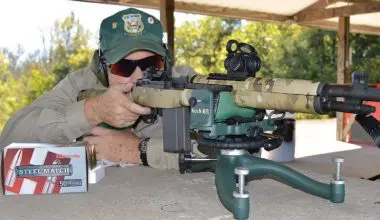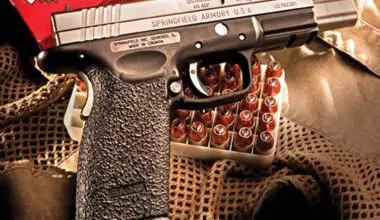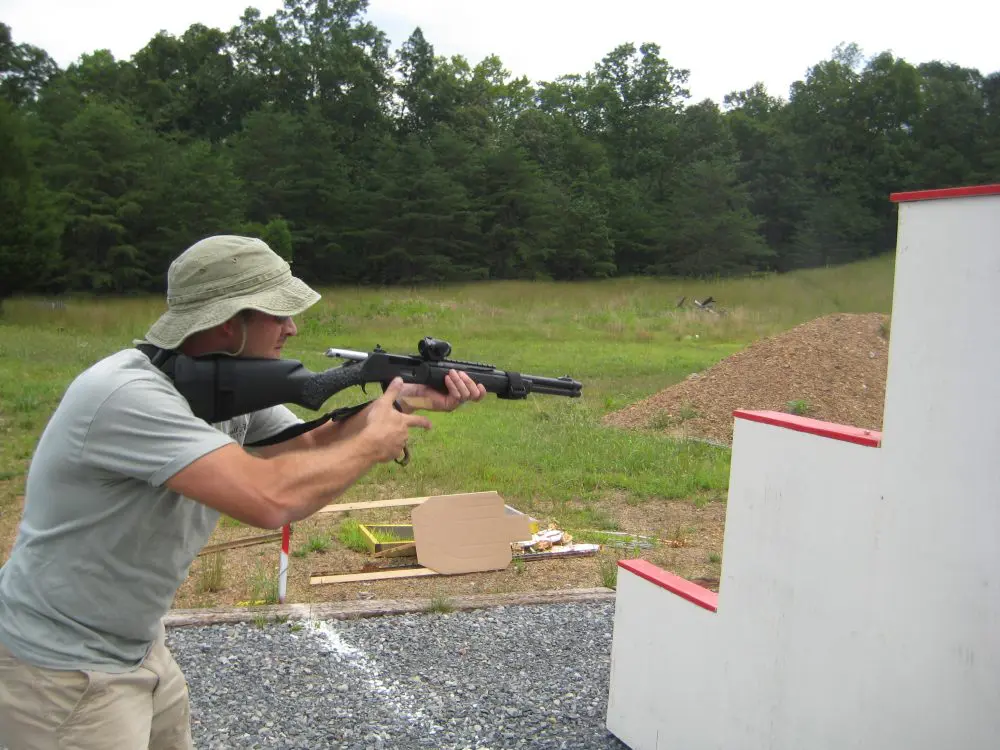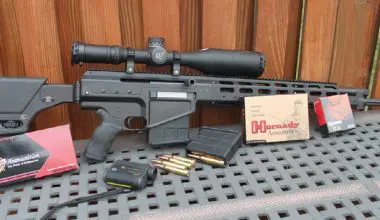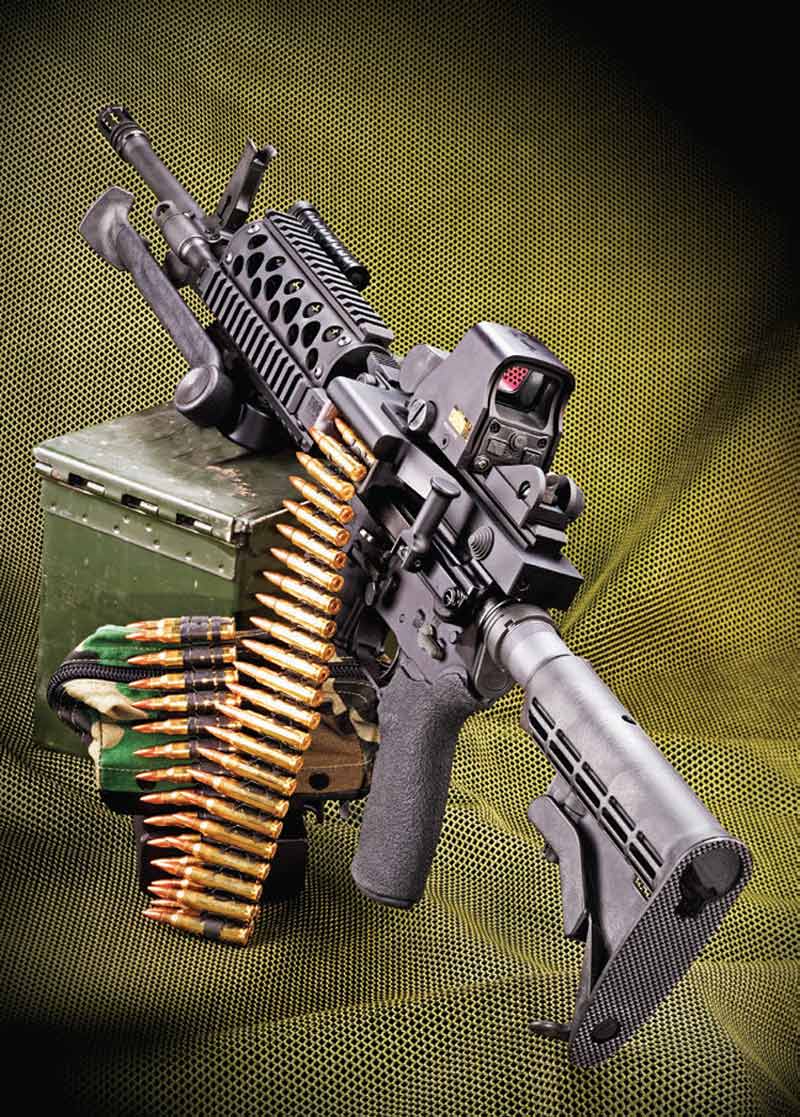
There is an old adage that goes, “Jack of all trades, master of none.” While being well rounded is a good thing, would you really want a plumber putting a new electrical system in your home or having an electrician work on your truck’s transmission?
I learned at a young age to use the right tool for the job. Wouldn’t it be great if you could have one tool that could perform several missions with the same efficiency? In terms of firearms, the ARES-16™ from Ares Defense does just that.
The ARES-16 MCR™ (Mission Configurable Rifle) small arms family represents a military-grade state-of-the-art advance in compact, lightweight and mission-configurable weapons. The ARES-16 features a unique group from which a variety of firearms can be configured, including:
- Sub-Carbine
- Carbine
- Assault Rifle
- Designated Marksman Rifle
- Magazine-Fed Assault Machine Gun
- Belt-Fed Assault Machine Gun
- Dual-Feed Assault Machine Gun
- Belt-Fed Mounted Light Machine Gun
The ARES-16 MCR™ weapons are chambered for 5.56x45mm NATO, gas-piston operated, fire from a closed bolt, and feature MIL-STD 1913 rail interface system and quick-change barrels for ultimate mission flexibility. Depending on the mission, the barrel can be changed from one length to another in about 30 seconds.
Although the ARES-16 MCR is not the only AR-type rifle that allows the user to quickly change barrels, what sets this system apart is the feed mechanism. While it can be fed with standard AR magazines, it can also use the M27 linked ammunition that is used in the M249 SAW.
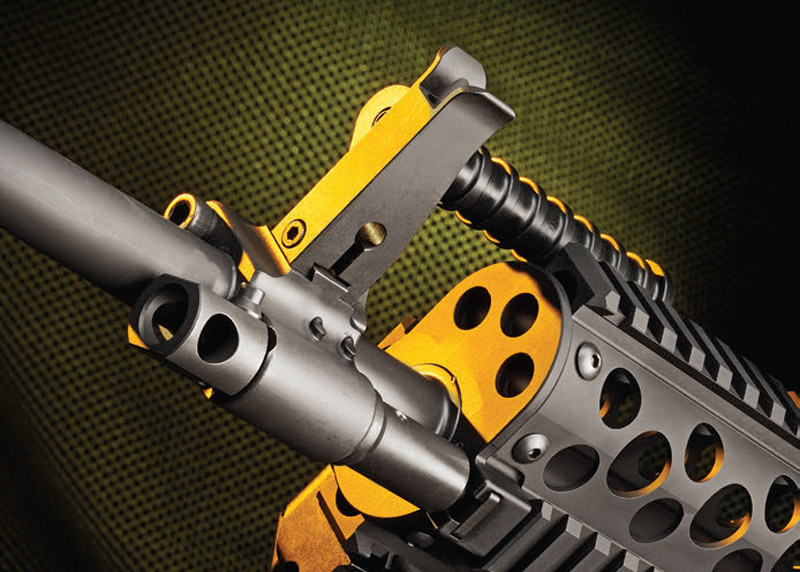
Table of Contents
ARES-15 MCR
I recently had the opportunity to evaluate the semi-auto sibling of the ARES- 16 MCR—the ARES-15 MCR (15 MCR). The weapon is not restricted to government/ law enforcement sales.
Before we go any further, some may be asking why they would want a beltfed AR that is only capable of semi-auto fire. For a gun enthusiast, the answer is threefold: it’s unique, it’s fun, and simply because we, as Americans, can.
Of course if you want to experience full-auto fire and burn ammo at the cyclic rate, there is a way to do it. More on this later.
[Personally I believe that any citizen should be able to own Class III weapons capable of automatic fire, but that’s a subject for a different time.]
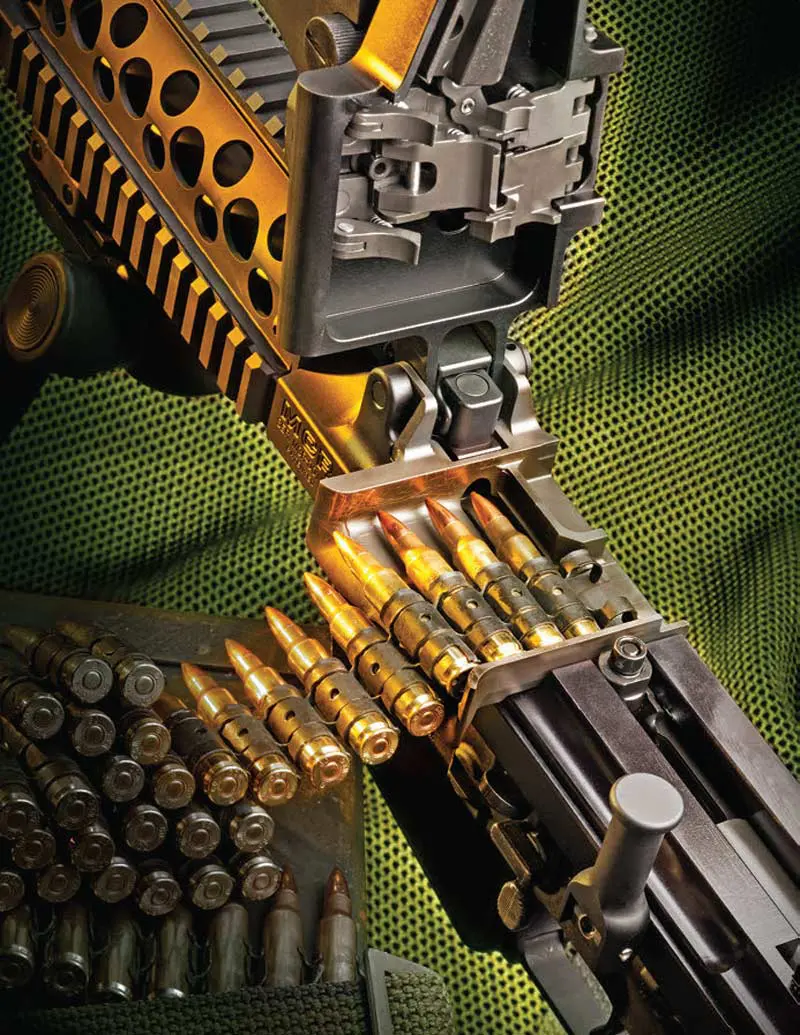
DESCRIPTION
The 15 MCR evaluated came in a hardsided case and included two barrels— a 16-inch and a 20-inch. Also included were a 100-round M249 ammo pouch (commonly called a nutsack), 30-round PMAG, aluminum magazine adapter that allows the pouch to be attached to the rifle using the magazine well, and a small quantity of M27 links.
The front-sight housing is integral with the gas regulator. The gas regulator has four positions, including an “off” position (position 4). In this position the rifle will fire, but an empty case will not be ejected or a new round chambered. The lowest gas position will eject the brass slightly to the rear, and the next will eject it to the side of the shooter. The last position is the strongest and will eject empties toward the front of the shooter.
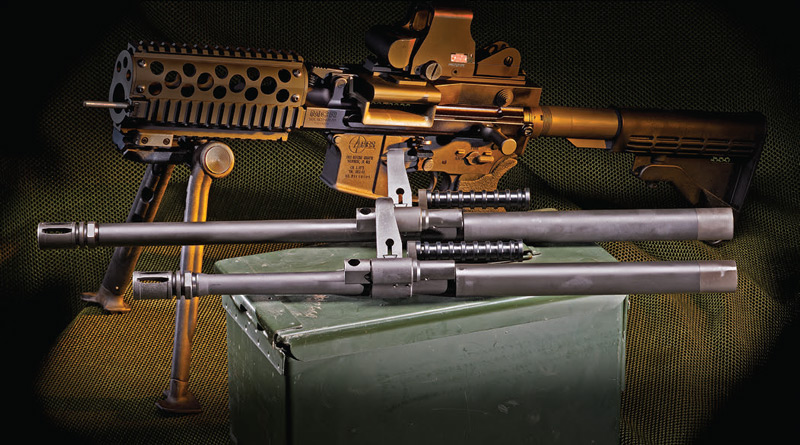
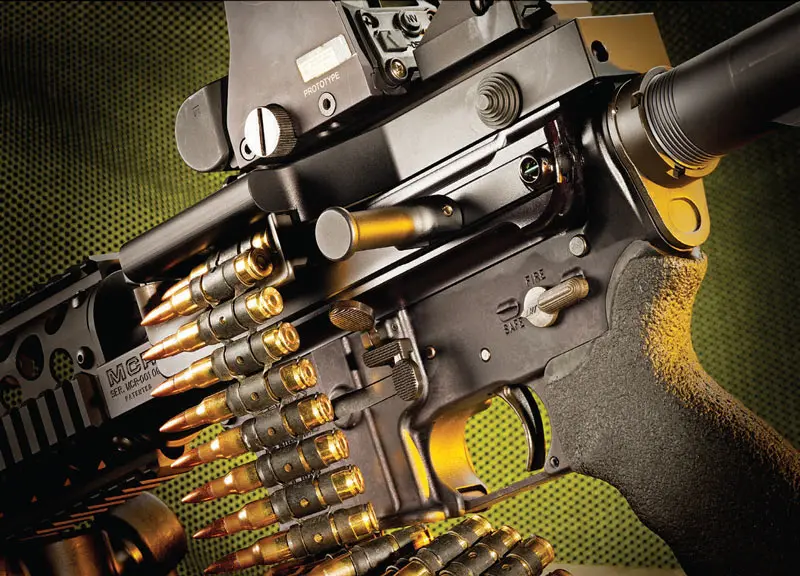
The gas regulator is easily adjustable by depressing a spring-loaded detent and turning the regulator to the position desired.
As mentioned earlier, the ARES-16/15 MCR is a piston system. Unique to the Ares guns is the fact that the operating rod runs along the right side of the barrel instead of on the top.
At the left top rear of the upper receiver is a serrated pyramid-shaped button. Pushing the button forward allows the feed cover to be rotated up to insert a linked belt of ammunition. Once the first round is in the feed tray, lower the cover and either forcefully snap it closed or push the feed cover button and close the cover. Be sure the button has returned to its locked position before attempting to fire. When linked ammunition is not in place, the rifle can be loaded with a magazine in the normal fashion.
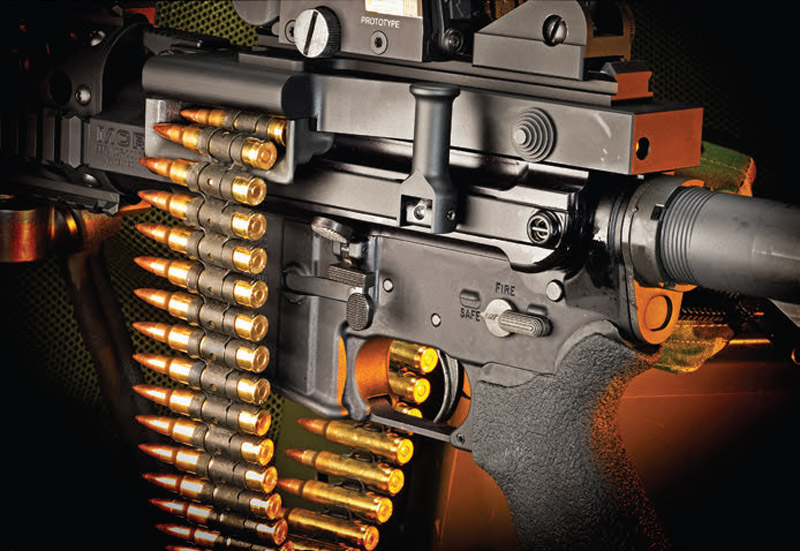
The charging handle is located on the left side and is designed to fold alongside the rifle so as not to snag on anything, including your gear. Rotating it 90° allows it to be easily manipulated.
Unlike the bolt release on standard ARs, there are paddle-shaped levers for both releasing the bolt and holding it open.
On the top front of the upper, just before the rail, there is a lever that is used to change the barrels. When the lever is depressed, the barrel can be removed by pulling it forward.
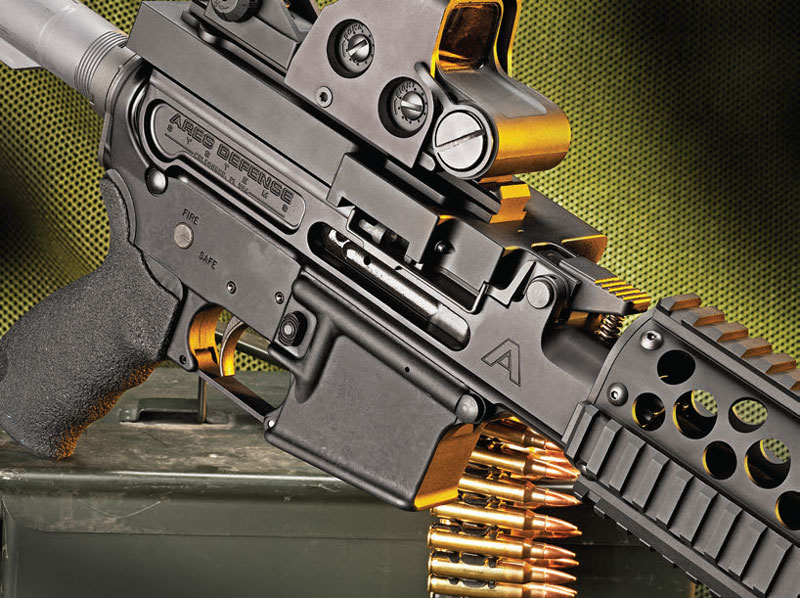

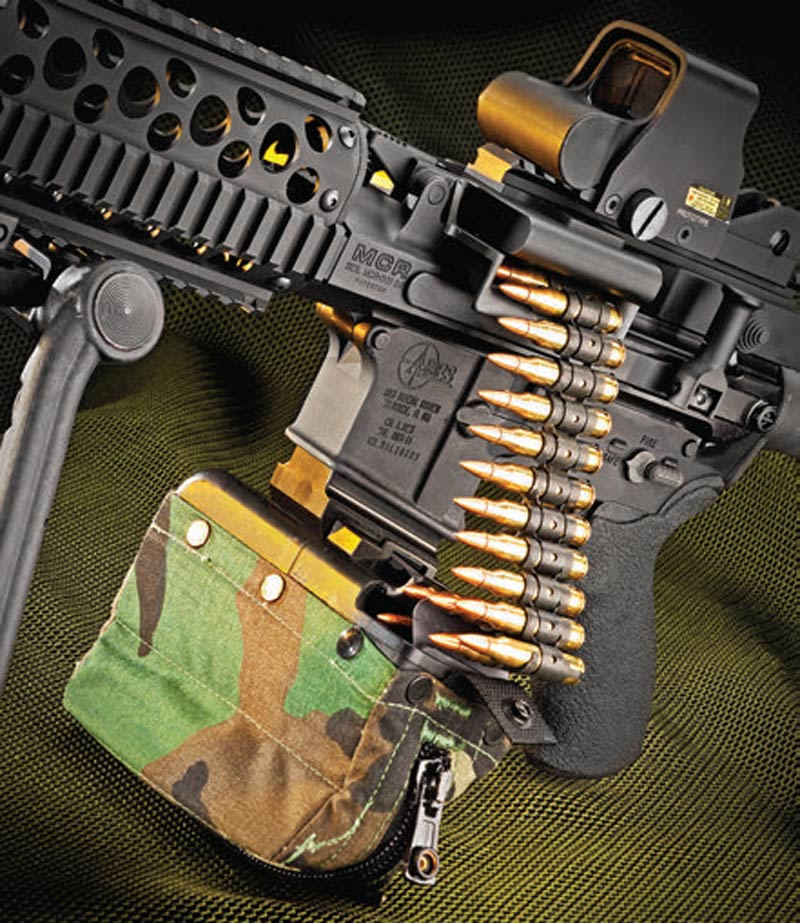
To replace the barrel, push it in until it stops against the front of the upper, depress the lever and then slide the barrel in until it stops against the quick-release pin. Release the lever while you align the pin and barrel extension. The barrel is in the correct position when the pin is just below the surface of the receiver and the ring on the barrel is lined up with the handguard. Pull forward to make sure the barrel is locked in position.
The barrels are equipped with a handle to be used when the barrel is too hot to touch.
The ARES-15 MCR does not have a forward assist—a good thing in my opinion.
Separation of upper and lower receivers is accomplished in the same manner as any other AR-type weapon.
RANGE EVALUATION
I assembled 14 different loads from six manufacturers that included American Eagle, ASYM, Black Hills, Federal, Hornady, and Summit. Bullets ranged in weight from 55 to 77 grains. To establish velocity, ten-round strings of each load were fired with both 16- and 20- inch barrels to establish velocity using a PACT Professional XP chronograph.
To evaluate how well the 15 MCR would run with a variety of magazines, I used mags from Bravo Company, Fusil, Lancer, Magpul, TangoDown and USGI.
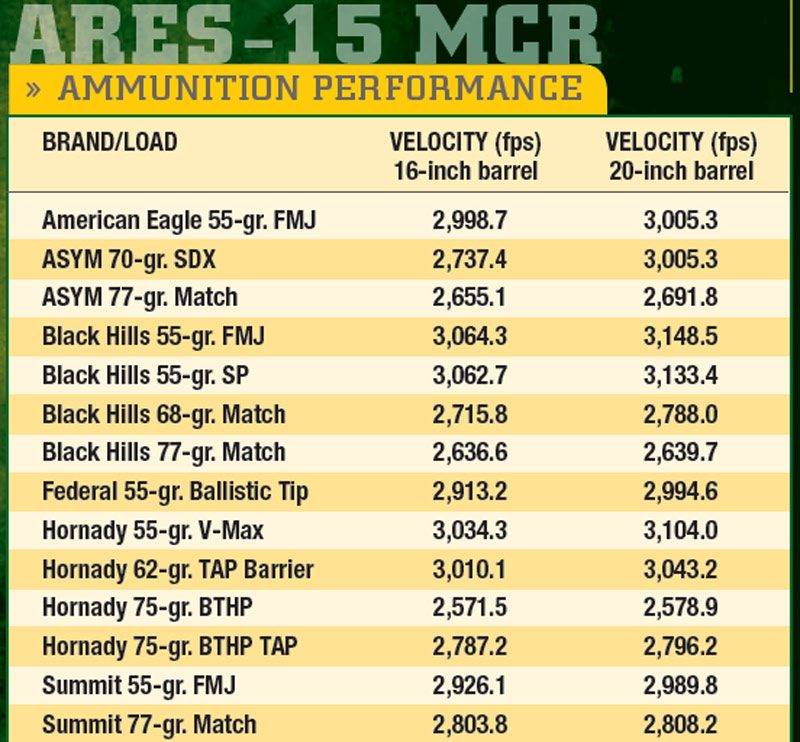
To save time as well as ammunition, the accuracy testing was performed in conjunction with the chronograph reading. Testing was performed from a bench at 50 yards using the issue iron sights.
With the 16-inch barrel, groups were in the 2½- to 3-inch range, and the barrel seemed to have a preference for 55-grain ammo.
Changing to the 20-inch tube with its longer sight radius, most groups went just under two inches. Curiously, the 20-inch barrel seemed to like the heavier 75- and 77-grain Match loads.
The fastest load from both barrels was the Black Hills 55-grain FMJ loading, clocking 3,064.3 feet-per-second (fps) and 3,148.5 fps respectively.
It’s worth pointing out that the velocity increase between the 16- and 20- inch barrels was—for all practical purposes— insignificant. Velocity increase for one 77-grain Match load was a mere three fps and for lighter loads, the difference was around 80 fps or less.
In terms of accuracy, slightly better groups can be achieved with a longer barrel if iron sights are used, because of the longer sight radius. But if optics are used, it becomes a moot point.
With initial accuracy and velocity testing out of the way, I mounted an L3 EOTech XPS3 holographic sight on the 15 MCR and installed the 16-inch barrel. Turning down the intensity of the red dot to give the illusion of a smaller aiming point, groups shrank dramatically. Giving a few thousandths of an inch, Black Hills’ 68-grain Match and Hornady’s 75-grain TAP tied for top honors, going in .75-inch (still fired from 50 yards from a seated rest).
Functioning up to this point of the evaluation was 100% with all magazine and load combinations.
FULL AUTO
Earlier I talked about going full auto. Unless you own a registered full-auto receiver, this may seem an impossibility, but there is a product that lets you replicate the group therapy setting.
The Slide Fire Solutions SSAR-15 stock (THE SMILE STOCK, July 2011 S.W.A.T.) is a BATF-approved product that can simulate full-auto fire using the “bump fire” technique. The only modifications necessary are to remove the issue collapsible stock and exchange the pistol grip for what Slide Fire calls an Interface Block.
I removed the issue stock and pistol grip and installed an SSAR-15 stock and Interface Block. Total installation time: less than five minutes.
For this portion of the evaluation, I also attached a TangoDown Advanced Combat bipod to the 15 MCR. OK, it really was not much of an “evaluation”— I was going to have some good old-fashioned fun and spend some quality time on the range with my grandson Austin.
With a 100-round belt placed into the M249 ammo pouch and attached to the supplied magazine adapter, we were ready to turn good ammo into empty cases.
The ARES-15 MCR owner’s manual clearly states that the rifle requires a break-in period and suggests the initial firing of the rifle be performed with the gas regulator set at the strongest setting. Up until this point, I’d had the regulator set at the middle setting. I should have RTFM.
I initially experienced failures using linked ammo. The fired case would eject, but not the link. I lubricated the rifle and set the gas regulator at its highest setting. This cured any future malfunctions, and Austin and I proceeded to burn ammo until there was a pile of links and empty brass.
With the exception of the failures with linked ammo—which I take the blame for—the ARES-15 MCR proved to be reliable and as accurate as most of my AR-type rifles. And firing it with links off the bipod with the Slide Fire stock was more fun than I’ve had in some time.
Let’s be honest: most of us have no real use for a belt/magazine-fed AR. On the other hand, many of us may want one because of its unique characteristics. That’s reason enough for me.
